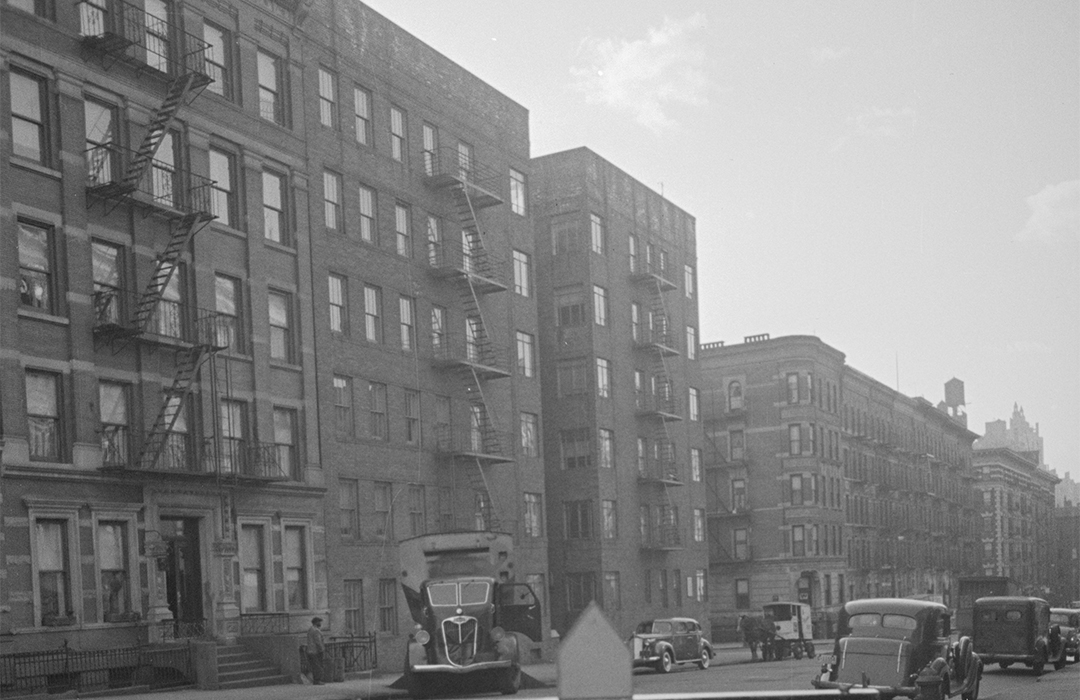
50-56 Manhattan Ave.
by Tom Miller
In 1885, when New Avenue was renamed Manhattan Avenue, development had reached as far north as 104th Street. Nearly a decade later, in 1894, developers Van Orden Brothers filled the southeastern blockfront of Manhattan Avenue between 102nd and 103rd Streets with four, five-story brick and stone apartment buildings. Designed by W. O. Tait, the ambitious project cost the developers $79,000 to erect (just under $3 million in 2025 terms).
Four decades later, in 1937, Academy Properties, Inc. obtained a demolition permit to eradicate the vintage buildings. The firm hired H. Herbert Lilien to design a six-story replacement with eight apartments per floor. Lilien had earned a reputation for his Art Deco-style apartment buildings. Now, as architectural tastes morphed, he designed 50 Manhattan Avenue in the emerging Art Moderne style.
Like Art Deco, the Art Moderne style relied on clean lines and geometrical decoration. Perhaps because of the financial restraints brought on by the ongoing Great Depression, the resultant structure was architecturally unexciting. The U-shaped building was faced in variegated brown brick. Band courses of a darker shade or brick helped to relieve the monotony of the otherwise featureless facade. Slightly projecting brick in the parapet created blind panels. Rather than wrap the corner windows—a common feature of Art Moderne-style apartment buildings—Lilien separated them with full-height brick piers, thus eliminating the potential “wow” factor.
certain tenants were closely watched by the Federal Government.
From the opening of the building, certain tenants were closely watched by the Federal Government. In the 1930s and early 1940s, Dorothy and E. Hloboky were annually listed as voting along Communist Party lines in the annual record of Congress’s Special Committee on Un-American Activities. They were joined in the list in 1942 by Jerome and Jennie Stern. The couple appeared here as late as 1950 when they were also included on the list of members of “Communist Activities in Alien and National Groups.”
While most tenants were not concerned about the Government tracking them, they had another issue to fear. In July 1944, the newly formed 50 Manhattan Avenue Corporation purchased the building and immediately discontinued the doorman and porter services. That initiated a string of frightening and dangerous break-ins and burglaries.
On January 15, 1947, The New York Sun published a photograph of resident Alice Turner. The caption explained that she was “showing the peephole through which she says she saw an intruder at 50 Manhattan avenue.” It was not the first time Turner had encountered an uninvited person in the building. On October 3, 1946, she was “held up in the self-service elevator,” reported The Sun. She was forced to the roof, where the crook took her diamond ring and left her bound and gagged.
Numerous occupants of 50 Manhattan Avenue were victims of break-ins and robberies. Phoebe Vernick, who formerly worked as a dancer under the name of Anita Hammond, worked in the ground-floor doctor’s office of her husband. On January 14, 1947, a man tried to climb into the office through the window. She told police that when that failed, he entered the lobby and rang the office bell. Through the door, she told him she’d admit him in a moment, then called the police.
six complaints had been filed for burglaries…
Mrs. Vernick told reporters, as well, that intruders had stripped the lobby of a rug, “a cigarette urn, and sofa cushions” during the first weeks of 1947. Between February 1946 and February 1947, six complaints had been filed for burglaries, property damage and molestation. The worst incident by far came on February 23, 1946, when 37-year-old Jessie Zigler was found in her ransacked apartment strangled to death.
The terrified tenants met and decided to hire armed guards, day and night, and to pay their salaries through contributions. But even that ploy had problems. On February 14, 1947, one of the guards walked off. “This job is too much for me,” he said.
Not all the publicity, of course, was negative. Ruth Mulhusk’s son from a previous marriage, L. R. Nelson, joined the U.S. Army and served four years, including duty in the Pacific during World War II. Following his discharge, he returned to 50 Manhattan Avenue and was still living here in February 1953 when he became engaged to Gloria Osti.
Other than replacement windows and the painting of the ground floor level, 50 Manhattan Avenue looks much as it did in 1937 when the first tenants move in.
Tom Miller is a social historian and blogger at daytoninmanhattan.blogspot.com


